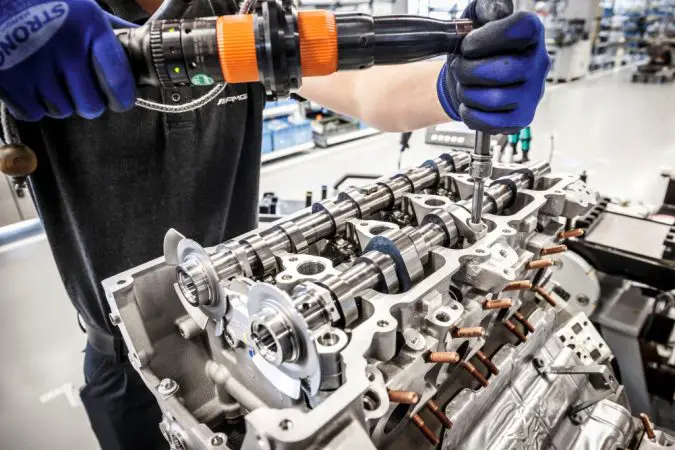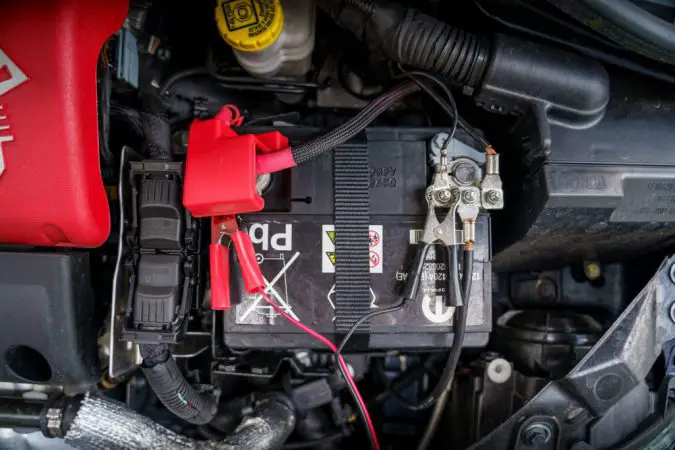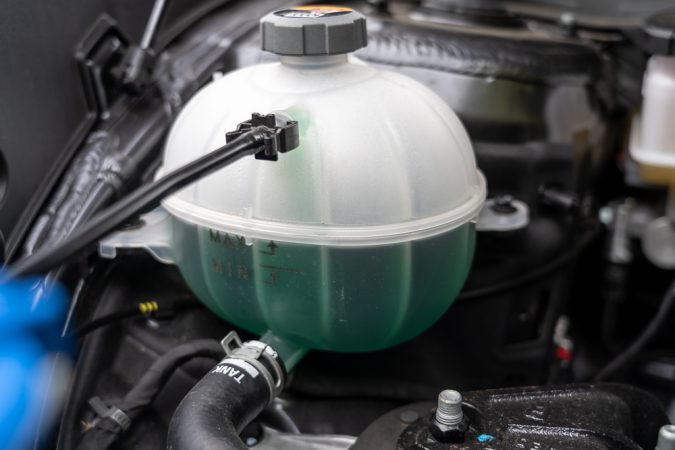Is your car running hot but not overheating? This article discusses why the temperature gauge is important and why the vehicle isn’t overheated when it reads high. Most drivers never check the temperature gauge in their vehicle, yet it may tell you a lot about the state of your vehicle. Manufacturers have stopped installing temperature gauges in their autos since they are rarely used. The temperature gauge only illuminates when the car’s temperature is too hot or cold.
The temperature gauge isn’t as complicated as you may imagine, and it can be set to read in the middle of the gauge throughout a wide temperature range. So, if the temperature gauge is all the way up but the car isn’t overheating, you’re in for a strange scenario. This is because when the car is overheating, the temperature gauge is supposed to be set to hot.
- How To Read Gauge?
- Car Running Hot
- When Gauge Is Hot?
- Repair Gauge
- How To Fix It?
- Tips
- Final Verdict
How To Read A Temperature Gauge
Some cars have temperature gauges that are wired differently than others. A coolant temperature sensor with two wires leading to the cluster is seen in some vehicles. The engine control unit is frequently absent in cars that use coolant temperature as information.
Modern automobiles use an engine control unit that uses the coolant temperature to calculate the proper air-fuel mixture at various temperatures. The coolant temperature sensor’s wires first go to the engine control unit, and then the information is relayed to the cluster.
Why Is My Car Running Hot But Not Overheating?
There are a number of possible causes for your car running hot but not overheating. It is critical to ensure that you are driving at the correct temperature. You can use a professional OBD2 scanner to thoroughly diagnose this problem. When an issue like this occurs in the vehicle, an error code is communicated to the diagnostics unit, and it is recorded here.
This diagnostics unit will be read by an OBD2 scanner, which will display the problem codes stored within. The error code will then be translated by the professional diagnostics program, and you will be told what it signifies. If there’s an issue with the temperature of the temperature gauge, you’ll know exactly what’s wrong and how to correct it.
- Failure in temperature sensor
- The temperature gauge is broken
- Insufficient coolant or air in the system
- Failure of the head gasket
- A broken water pump
- Engine overheating
- Engine overused
- The failed engine control unit
- Corrosion in connectors
- Damaged wires to the sensor or gauge
1. Failure In Temperature Sensor
The temperature sensor is used to determine the engine’s temperature. If the temperature gauge reads that car running hot but not overheating, you may be getting a false measurement. This indicates that the temperature sensor has failed or has malfunctioned.
Because a malfunctioning sensor isn’t sending out correct readings, the car may respond by sending out a misleading high-temperature gauge signal instead. If the sensor is stuck or has debris on it, it may become impaired while driving. Additionally, if the sensor’s connections are destroyed, the sensor will be ruined. Clean and inspect your temperature sensor if you get a fake high-temperature reading.
2. Temperature Gauge Is Broken
If the temperature gauge is broken, the car will not be able to tell you when it is too hot. When the temperature gauge breaks, the needle can shatter and become stuck when the temperature rises to a dangerous level. Grease can also cause it to become stuck.
There are also gears that allow the requirement to move, which can become damaged. The needle must be repaired if it is broken, which may be done at your local dealership. The sensor itself may be broken and will need to be replaced.
3. Insufficient Coolant Or Air In The System
If the engine is overheated, your temperature gauge may read hot. The most typical cause is a lack of coolant or air in the system. If your gauge is reading hot, double-check that your engine isn’t overheating. Make sure you have coolant and that no air got into the system when you changed the coolant.
4. Failure Of The Head Gasket
The coolant, combustion chamber, and engine oil pass are all sealed by the head gasket. If you have a leaky head gasket, your car’s temperature indicator may rise. Because it establishes a seal between the engine block and the cylinder head, the head gasket is an important part of your car engine. As a result, any damage to the head gasket might cause serious problems with your vehicle.

5. A Broken Water Pump
The water pump is an important part of the cooling system in a car. The coolant is pushed throughout the cooling system with the help of the water pump. The water pump can fail, resulting in a lack of coolant flow.
A water pump might fail for a variety of reasons. They are as follows:
- Breakage of the shaft
- Seal leakage
- Casting damage
6. Engine Overheating
If your car running hot but not overheating, it could be because you aren’t aware of it. Low coolant or oil might cause the engine to overheat. In this case, you must ensure that the coolant level is maintained. Continuing to drive while your vehicle is overheating might cause the engine to wear out faster, reducing its longevity.
7. Engine Overused
If the engine has been overworked, the temperature gauge may have risen without your knowledge. If you’ve been driving for too long, on rocky terrain, or if you’ve been accelerating for a long time, the engine can become overworked.
In this situation, you’ll need to come to a complete stop and allow the engine to cool down. After the engine has cooled down, you can resume driving and see if the vehicle is still hot.
8. Failed Engine Control Unit
Though the engine control unit fails, the temperature gauge can rise even when the car isn’t hot. This is a rare occurrence, and it results in the temperature gauge receiving incorrect data from the ECM, which sends data to the cluster. If you wish to double-check, you can use an OBD2 scanner to look for any fault codes that give temperature data.
If the temperature measurement in the engine control unit differs from the temperature reading in the cluster, make sure they’re both using the same sensor. A mechanic will need to check this so that the proper actions may be taken.
9. Corrosion In Connectors
Corrosion can be found in the connectors at the sensor, the cluster, and the engine control unit. You’ll need to clean the spray and the connectors in this scenario. Brake fluid can be used for this. If you discover corrosion, it’s likely that they need to be fixed because they’ve worn down.
10. Damaged Wires To The Sensor Or Gauge
Faulty wires to the sensor or gauge might cause the temperature gauge to display the incorrect temperature i.e. car running hot but not overheating. Wires can be run straight from the sensor to the cluster or to the engine control unit. You should inspect these two components for any damaged wires.
What Should You Do If Your Car Is Running Hot?
If the temperature gauge is high, you should pull over to the side of the road and look at what’s going on. If the engine is seriously overheated and you aren’t aware of it, you must pull over. Make sure the air conditioner is turned off and the windows are open.
Once you’ve stopped running the engine and other equipment in the car, check the temperature gauge to see whether it starts to drop. Whether nothing happens after you’ve done this, wait a few minutes and check to see if the temperature gauge has dropped. If not, you’ll need to visit your local dealership to have the issue diagnosed.
When Do You Need To Repair Your Temperature Gauge?
If your temperature gauge is broken, you’ll get false readings indicating that car running hot but not overheating. It’s critical that you figure out why this is happening and get it fixed as soon as possible since if you don’t, you can end up with terrible mileage.
- If you discover that your temperature gauge is shifting and giving you inaccurate readings which tell that your car running hot but not overheating, it’s time to replace it.
- If the needle stays in the same spot for several minutes and does not move out of the red zone, the gauge may be broken. To correct this, you must go to the dealership and get it repaired.
- Another clue that it has to be fixed is if the temperature reading stays between 80 and 100 degrees while you’re driving.
- If you examine the radiator cap and see that it isn’t properly closed, the temperature indicator may display inaccurate numbers. When you drive slowly or idle, you may notice that the temperature gauge changes from normal to chilly. This is an indicator that the temperature gauge is damaged.
- If your car’s mileage begins to fall, it’s possible that the temperature gauge has to be replaced.
When The Car Running Hot But Not Overheating, How Can You Fix It?
If your car’s temperature gauge is in the center when you’re driving, there’s a problem because it should be between cold and midway. It may begin to move towards the red on the gauge but then return to the midpoint.
A stuck thermostat or a cooling fan that isn’t working properly could be the cause of your car’s temperature gauge swinging up and down. The flow of coolant in your car’s engine is controlled by the thermostat.
When your thermostat isn’t working properly or is stuck closed, it prevents coolant from flowing properly through your engine. The engine temperature may change or remain hot as a result of this. The coolant might circulate regularly while the thermostat is jammed open, causing the motor to fail to reach the proper operating temperature.
The cooling fans may be running irregularly due to a faulty cooling fan relay or resistor. If the relay fails, the fan may turn it on at random, stay on all the time, or not turn it on at all. The resistor, on the other hand, controls the stages at which the fans turn on.
To discover cables and components to remedy this problem, you may need to consult your car handbook. Grounding the wire that connects to the temperature sending unit may be necessary, however in some circumstances, grounding the wire can harm the temperature gauge.
How Can You Fix It?
- If the check engine light is illuminated, you should first look for diagnostic trouble codes (DTC). The codes could lead to the problem’s origin.
- Before unplugging cables, make sure the ignition switch is turned off.
- Then, to avoid damaging the computer, turn the ignition switch on to check the gauge or warning light response.
- Turn the ignition off and unplug the electrical connector for the sending unit.
- Then press the “On” button on the ignition switch.
- Whether the engine is warmed up or chilly, the gauge should read cold after following the steps above.
- Ground the signal line with a jumper wire, then turn the ignition switch “On.” It should say “hot” on the gauge.
- The sending unit may be malfunctioning if the temperature gauge responds but not when linked to it.
- If the temperature gauge reads anything other than “cold” when you unplug the sending unit, you should unplug the wire at the temperature gauge. The wire is shorted if the gauge measurement is “cold.”
- If the gauge still reads higher than “cold,” the gauge may need to be replaced.
- Check the circuit fuse again if the gauge does not read “hot” when the wire is grounded. If everything appears to be in order, ground the gauge terminal where the wire attaches.
- If the gauge reads “hot,” you’ll need to inspect the wire for damage.
Should You Be Concerned When Car Running Hot But Not Overheating
The coolant temperature is indicated by the gauge in most automobiles, and it can provide the driver a rapid warning regarding the coolant system. Your engine should be running at a typical temperature of 195 to 220 degrees Fahrenheit, and most gauges will be unable to display this exact temperature. The temperature gauge should be around the middle and not running hot when the engine is functioning at a regular temperature.
The temperature gauge is broken if you notice the temperature is running hot and you can feel it in the vehicle or engine. The needle may never reach the middle of the gauge in some vehicles, which is a good thing.
When you get up to start your vehicle and notice that the temperature gauge is higher than normal, wait a few minutes for the engine to warm up before checking the temperature gauge. The typical temperature for your engine will be wherever the temperature gauge is.
What Can You Do To Keep Your Car From Running Too Hot?
1. Park Your Car In A Shady Area To Prevent It From Running Hot
The temperature difference between the shade and the sun can be felt by you and your car. Parking in the shade not only keeps you cool, but it also helps your car last longer. Is there no shady spot? Reduce the heat inside the car by using a shade.
2. Use Window Blinds In Your Car To Avoid It From Running Hot
Window shades in your car are a fantastic idea because you can’t always rely on finding a shaded or covered parking spot. These UV heat shields will keep your interior cool while also shielding it from damaging UV radiation.

3. Get Your Windows Tinted So The Interior Of Your Car Won’t Get Hot
Window tinting or window film (to find out more about the process, check out our guide on how long does it take to tint windows) can be applied by a local dealership or auto body shop to help keep your car cooler and protect it from UV rays.
4. Leave The Car Windows Left Open To
Hot air is trapped behind closed windows, and the glassworks as a conductor, causing the enclosed room to heat up. Allow the air to leave by gently opening your windows.
5. Activate The Floor Air Vents
To get the air flowing, most people hop in their car and crank the vents on “high.” However, it is preferable to direct the air through the floor vents. Because hot air rises, send it to the bottom vents and turn on the highest setting on your blower to blast it out. Once the car has begun to cool, the upper vents can be opened.
6. Instead Of Recirculation, Use The Fresh Air Setting On Your Air Conditioner
For around 10 minutes, turn on the fresh air setting on your air conditioner. When you utilize the recirculation option, you’re just moving that hot, trapped air around your vehicle, so it’s something you’ll want to do after it’s cooled down.
7. Keep An Eye On The Temperature Indicator In Your Car If It’s Running Too Hot
The device, which is mounted on the dashboard, has a needle that should always be pointing toward the center. If the automobile is getting heated, pull aside, turn off the engine and let it cool down.
8. To Cool The Engine From Running Too Hot And Overheat, Turn On The Heat
On a hot summer day, turning on the heat may be the last thing you want to do, but it may suck hot air from the engine compartment and cool it. It won’t solve the fundamental issue, but it’s a sensible precaution to take on lengthy drives.
9. Fill The Engine With Coolant To Prevent Your Car From Running Too Hot Or Overheating
This is particularly critical during the summer months. Open the hood and look for the coolant reservoir to check the coolant level. On the reservoir, indicator lines show the coolant level. If the coolant level is too low, simply add more coolant and reconnect the cap.
A 50/50 mixture of water and coolant is commonly offered as an engine coolant. You can also purchase concentrated coolant and make your own mixture. Never add coolant to a hot engine as a precaution. Before removing the cap or pouring in coolant, let the engine cool down.
10. Have A Mechanic Flush The Radiator So Your Car Won’t Overheat
Even if you maintain proper engine coolant levels, it will eventually become unclean and require replacement. A radiator flush, also known as a coolant flush (in addition to learning how to flush coolant system or knowing where to get a radiator flush near me), consists of draining the old coolant from the radiator, cleaning it using flush fluid, and then refilling it with a new coolant.
Mechanics recommend flushing every 40,000 miles, but you should double-check the manufacturer’s recommendations in your owner’s handbook.
11. Consider Changing Your Car Battery
Your car battery may not be producing the same amount of power as it previously did if it is more than three years old, forcing your car to work harder and maybe overheat. Your mechanic can help you figure out whether you need a new battery or not.

Is It Possible For The Car To Run In A Hot State?
In theory, most models can continue to run normally if the overheating threshold is not reached. However, if the temperature increases to dangerously high levels, you should stop the car immediately. Since it is not essential to reach superheat, the car will start to have issues even if it gets to a particular temperature threshold.
How Much Does It Cost To Repair Your Car Running Hot?
Regrettably, the expense of correcting engine damage caused by heat is very expensive. Most water pumps, auxiliary fans, and thermostat issues will cost between $500 and $1,500 to repair. If, on the other hand, the problem is solely with the cooling water, the repair will be significantly less expensive.
Facts You Need to Know
- An overheating car can cause massive engine damage, including cracks, oil leaks, and warped parts.
- The most common reasons for a car running hot but not overheating are related to the cooling system, such as a clogged or damaged radiator, low coolant, or a damaged water pump or thermostat.
- A broken thermostat is often the cause of fluctuating temperature gauge readings.
- A consistently high-temperature gauge reading could indicate an overheating engine, leaking coolant, or a broken thermostat or water pump.
- If the temperature gauge reading is consistently low while the engine is steaming, it could be due to a faulty temperature gauge or a stuck-open thermostat.
- If your car is overheating, stop driving it and pull over as soon as it is safe to do so.
- Turning off the A/C and turning up the heat can help relieve stress on the engine.
- Low or leaking coolant is often the cause of overheating, so it’s essential to check your coolant level and add more if necessary.
- If your temperature gauge is broken, you can test it with a multimeter to check its resistance value.
- Signs of engine damage from overheating include a cracked engine block, broken head gasket, warped cylinders, and melted or cracked seals.
Car Running Hot But Not Overheating; Final Verdict:
While you may like the summer heat, you must assist your vehicle in maintaining its cool when the temperature rises. So now you know why your car running hot but not overheating.
You’re aware that the most typical cause of an overheated engine is a lack of coolant, but you’re also aware that the temperature gauge can sometimes produce erroneous readings. These misleading readings are usually caused by the gauge breaking owing to worn and broken parts or the needle being trapped. A faulty temperature sensor might also result in incorrect results.
Check the temperature sensor and mechanical element of the temperature gauge if you’re getting high readings without an overheating engine. If none of these items is the issue, your engine may have been overheating, and you should have it checked out to avoid significant damage to your vehicle.


